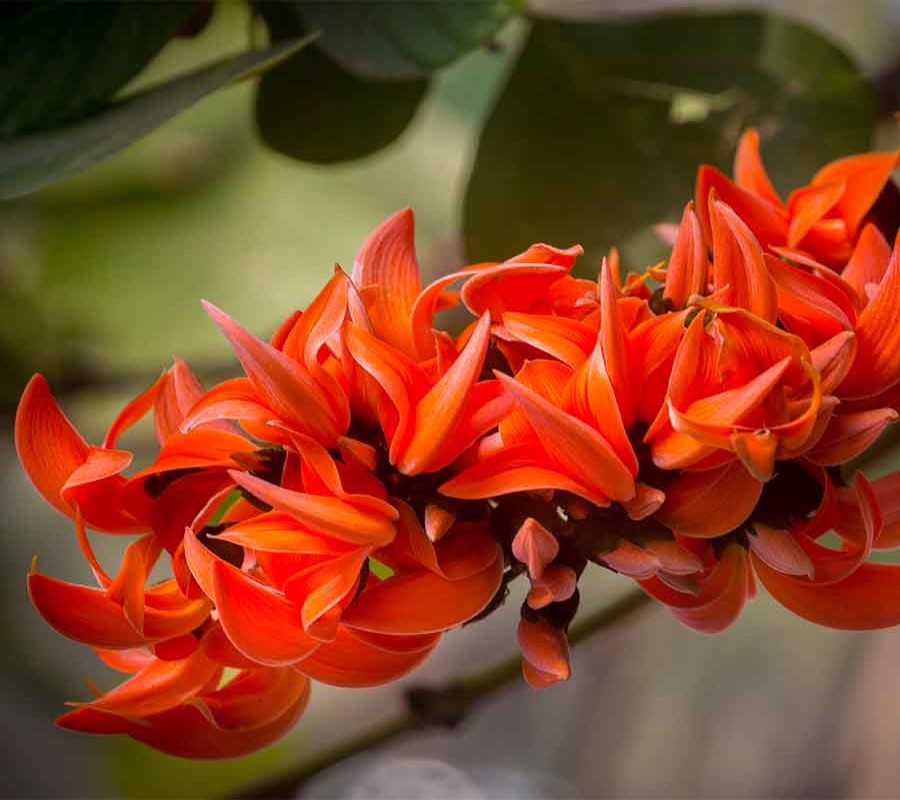The Palash Tree
The Palash tree, scientifically known as Butea monosperma, holds a profound significance in the valley, intertwining with its cultural, artistic, and historical aspects. Revered for its vibrant orange flame-like flowers, the Palash tree has become an emblem of spring in the region, celebrated through the verses and melodies of Rabindranath Tagore. Its association with the naming of Dhaka, the mega city, further deepens its historical importance, while its ornamental allure and traditional medicinal value make it an integral part of the valley's landscape.
The connection between the Palash tree and the naming of Dhaka adds a layer of historical intrigue to its significance. Legend has it that the city derived its name from the Bengali word "Dhak," which refers to the Palash tree. The abundance of these trees in the region, with their distinctive flowers, played a role in shaping the identity of the city and its cultural narrative.
Ecological Significance:
The Palash tree's dense foliage and nectar-rich flowers provide valuable habitat for a variety of birds, insects, and small animals. The tree's extensive root system helps to bind the soil, prevent erosion, and promote land conservation. The Palash tree has the ability to fix nitrogen from the atmosphere, enriching the soil and benefiting other plants growing nearby.
Medicinal Significance:
- Anti-inflammatory and Antibacterial Properties: Studies have shown that various parts of the Palash tree possess anti-inflammatory and antibacterial properties, offering potential benefits for treating infections and reducing inflammation.
- Antidiabetic Properties: Research indicates that the Palash tree may have antidiabetic properties, potentially helping to manage blood sugar levels.
- Wound Healing and Skin Care: Traditional medicine utilizes various parts of the Palash tree to treat wounds, burns, and skin diseases due to their antiseptic and healing properties.
- Other Potential Uses: The Palash tree is also used in traditional medicine for various ailments like diarrhea, fever, and jaundice. However, further research is needed to validate these claims.
References:
- "Therapeutic Uses of Butea monosperma" (2021): https://www.ejmr.org/articals/pdf/1672496681_c4d557eaa062a3c4f5bd.pdf
- "Butea monosperma (Palash) – Its Ethnobotanical Knowledge, Phytochemical Studies, Pharmacological Aspects and Future Prospects" (2023): https://www.researchgate.net/publication/359529092_Ethnobotany_Phytochemistry_and_Pharmacology_of_Palash_Butea_monosperma_Lam_Taub_a_Systematic_Review
- "The Ayurvedic Pharmacopoeia of India, Part 1, Volume 1": https://pcimh.gov.in/
Through Palash tree’s fiery blossoms, poetic associations, and contributions to traditional medicine, the Palash tree stands as a symbol of the valley's identity, connecting the past, present, and future in a tapestry woven with threads of beauty, culture, and resilience.
N.B: While the information provided highlights the potential medicinal uses of the Palash tree, it is important to remember that further research is needed to fully validate their efficacy and safety. Always consult with a qualified healthcare professional before using any part of the Palash tree for medicinal purposes.


